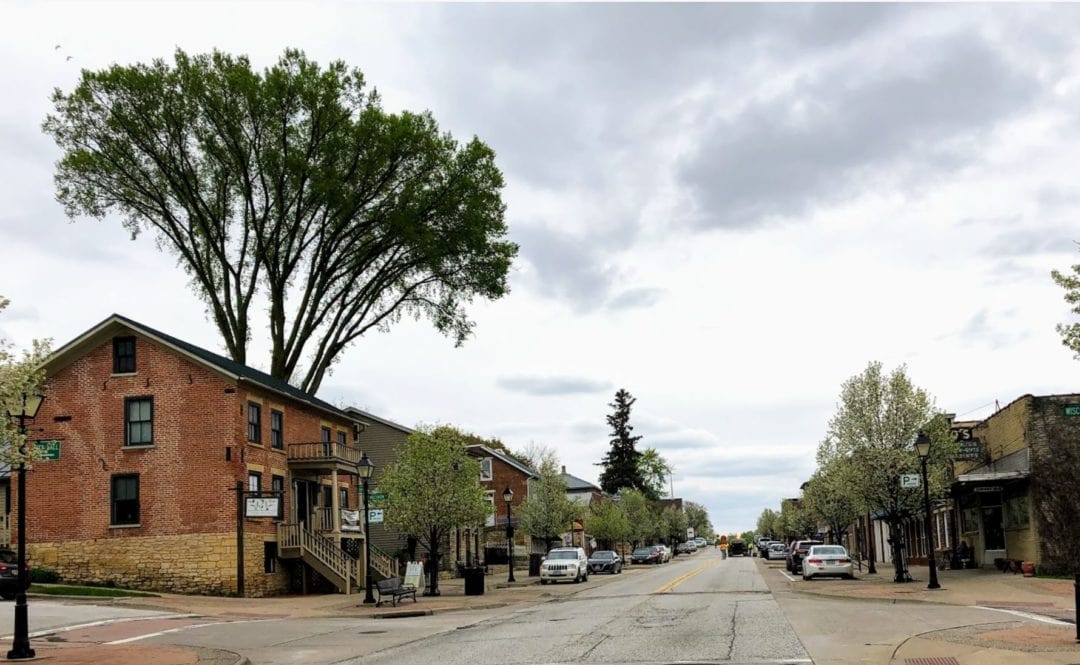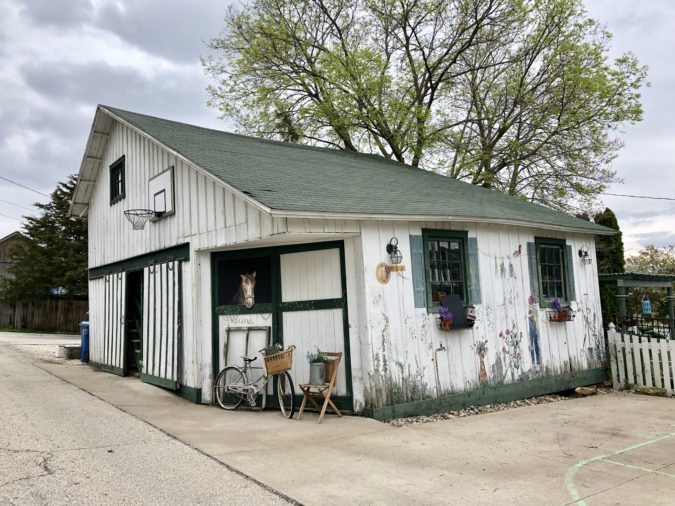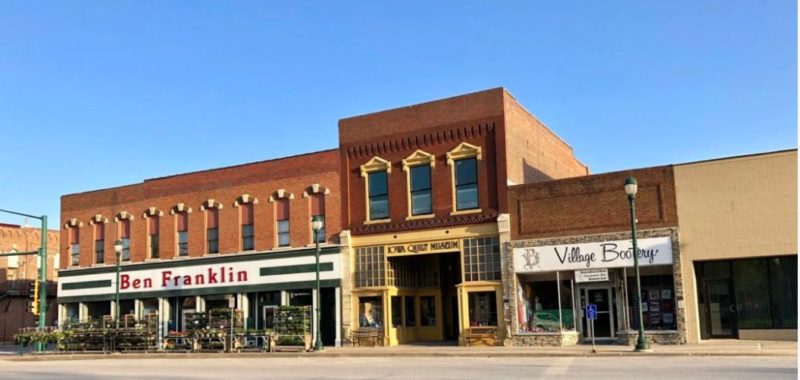The best part about taking a road trip is exploring the quirky, cute, and otherwise interesting towns you can stop in along the way. I’m talking about the kinds of places you definitely don’t see if you’re flying into an airport—the ones that make you realize that the journey really is the destination.
Iowa might seem like it’s all farming towns surrounding Des Moines, but that couldn’t be further from the truth. On a recent road trip to three of Iowa’s cutest small towns, I saw major Hollywood filming locations, experienced my first (and second) wine slushie, toured the birthplaces of some of America’s most famous icons, and took a side trip to the Netherlands.
Plus, my route took me along some pretty awesome winding backcountry roads. Even after three days, I wasn’t the least bit tired of driving the two-lane highways, especially in the perfect spring weather. I can now say with 100 percent certainty that road fatigue is strictly for interstates.
Here are some highlights from the three charming towns I visited.
Town: LeClaire
Best known for: Birthplace of Buffalo Bill and its location along the Mighty Mississippi
Vibe: Old-fashioned river town; I half expected an old-timey riverboat gambler to step off the docked Riverboat Twilight

There’s no way around it; LeClaire is a town that knows how special it is. Residents and businesses here lean into their historic small town allure by piping upbeat music throughout the downtown district, which draws in visitors looking for a weekend escape. And it would be easy to spend a full two or three days exploring every nook and cranny of the recently-redesigned Cody Road Cultural and Entertainment District.
For starters, the antiquing is excellent.
In addition to being the home of Antique Archaeology, made famous by History Channel’s American Pickers, there’s also Grasshoppers. It’s a boutique and gift shop located in a restored Mississippi River pilot’s Victorian mansion. But Grasshoppers’ real hidden gem is the barn out back, which displays antiques in a setting that can only be described as perfectly Instagram-worthy.


A big reason why I got some serious old-fashioned river town vibes is because LeClaire has all of your libation needs covered within less than a mile. There’s a winery, a brewery, a coffee-and-tea shop, and a distillery all within walking distance of the downtown area.
Wide River Winery serves a great variety of sweet and dry wines (some of which are made with grapes grown at their nearby vineyard in Clinton), as well as charcuterie boards and wine slushies by the pitcher. The brewery is called Green Tree, and I suggest you go for the beer but stay for the free popcorn and the incredible views of the river.
Royal Tea is a nonprofit coffee shop run by a local church, and it’s best known for its massive variety of tea blends, including herbal, green, black, and rooibos. And last but not least is the Mississippi River Distilling Company, which had 25 different cocktails while I was there, all of which were made with one of their house-made liquors.
There was something for every taste—mules made with the house vodka, tiki drinks crafted with whiskey, refreshing gin cocktails, a solid bourbon old-fashioned, and many, many more.

And there’s a lot of great dining to go along with these drinks. For a white tablecloth-kind of experience, there’s Steventon’s, serving steak and seafood, incredible house-made salad dressings, and killer martinis. Or go casual at Blue Iguana, which has a variety of frozen margaritas and the perfect blend of Tex Mex-meets-authentic-Mex offerings. After the chips and salsa for the table, try the tacos (which come in all varieties, from pollo to lengua). Don’t ignore the fresh-tasting pile of homemade rice and refried beans on the side, either.

Yet the most unique feature of LeClaire has to be the town’s guesthouses. While the town offers many of your standard chain hotels, there are about half-a-dozen home rentals right in the downtown area, all within easy walking distance of the major attractions. The LeClaire River Loft was an especially perfect spot to stay the night—its cozy, shabby chic decor meshed seamlessly with the town’s charming atmosphere. The rental can also sleep up to six people, and has a spacious porch and a yard complete with a firepit.

As for culture, the town is most notably home to the Buffalo Bill Museum. Buffalo Bill Cody, founder of the most famous 19th-century Wild West show, was born near LeClaire. But the museum doesn’t just highlight the legendary life and times of Buffalo Bill (though there are plenty of artifacts related to him), there’s also a sizable collection of Native American cradleboards, some Victorian hair art, and a massive room dedicated to preserving the last wooden paddle boat on the Mississippi, Lone Star.
This is quite fitting as the river is, in a lot of ways, the soul of the town. I left LeClaire just as the mist that rolled in from the Mighty Mississippi was dissipating into the warm, late morning air.
Town: Pella
Best known for: Tulips and the boyhood home of Wyatt Earp
Vibe: Like someone picked up Lisse and dropped it into the middle of Iowa

Next, I said “Goedenmiddag” to Pella, the cutest little Dutch town in Iowa. The town’s heritage can be seen throughout its bakeries, canals, and windmills scattered around. But to get a real feel for the town and its unique heritage, the best time to visit is in the spring.
Spring is when Pella goes all-out for its annual Tulip Time festival, which happened to coincide with my visit. The parks, the gardens, the historical village, even the sides of the main roads are all outfitted with hundreds of thousands of rainbow-hued tulips.
The residents also like to get involved, with people donning some their best old-school Dutch finery for parades, demonstrations, craft fairs, concerts, shows, and more. In fact, the town elects a “Tulip Queen” to preside over all of the festivities.


A tour of the Pella Historical Village and Vermeer Mill seemed like the best way to learn about the town’s special story—and it did not disappoint. In the mid-19th century, a company of 800 pilgrims—mostly well-to-do farmers led by a pastor—came from Holland to Iowa in search of religious freedom and separation between church and state.
The Historical Village is actually a recreation of what Pella might have looked like in those early days, with antique-furnished historical homes, and buildings displaying exhibits and demonstrations.
I got to see wooden clogs being made by hand, and I absolutely loved the displays of Dutch costumes through the years. The Village also happens to be in the same location as Wyatt Earp’s boyhood home. Earp was an American lawman and gambler back in the mid-1800s, and is best known for his involvement in the gunfight at the O.K. Corral—often referred to as the most famous shootout of the American Wild West.
Earp’s home, which is usually available for tours, is currently undergoing restoration.

The Vermeer Mill was another highlight. While Pella has several windmill-shaped buildings, the Vermeer Mill actually functions as a grain mill. And standing over 125 feet tall, it also happens to be the tallest working windmill in North America.
While it was quite the sight to see from the ground, adorned in flags and banners, the view from the top was even better (especially with the town in all of its Tulip Time finery). The inside of the mill, which was built in the Netherlands before coming to Pella in 2002, contains various exhibits on the everyday life of a Dutch miller.

I made sure to sample some Dutch treats while I was here, too. Specifically, a corn dog made with bologna instead of a hot dog and a plate of puffy, sugar-and-butter-drenched, mini-pancake-shaped poffertjes (which were well worth the long wait). It was the perfect fuel for my drive to the next and final destination.
Town: Winterset
Best known for: Covered bridges and the birthplace of John Wayne (who knew so many famous people were from Iowa?)
Vibe: Bridges of Madison County IRL (it was filmed here!)
You can’t visit Winterset without stopping by one (or five) of the covered bridges in town. There’s a well-marked Covered Bridges Scenic Byway route running all throughout town, so it’s very easy to find the bridges, despite many of them being located down secluded backcountry roads.
Even on my way to other stops, I’d drive past a Covered Bridges Scenic Byway sign and make a quick detour to visit the bridge. From here, I’d spot another sign for another bridge a few miles away and it quickly became a game to try and find as many of these bridges as possible.


My bridge game aside, some of the other attractions include the John Wayne Birthplace and Museum and the adorable town square. The centerpiece of the square is the ornate city hall building, which is surrounded by shops and restaurants—all watched over by the quaint Winterset water tower. The square is also home to the adorable Iowa Quilt Museum, which left me with a new appreciation for the craft.

I got an up-close look at two major Bridges of Madison County filming locations. First was actually my room (#3) at JASS Bed & Breakfast, which is where the final scene of the movie was filmed. Justin, who runs the B&B with his wife, was an incredibly gracious host, and the asparagus omelette they brought me for breakfast was one of the best things I ate the whole weekend. I also ate a great home-cooked dinner at the Northside Cafe, which happened to be the location where Clint Eastwood’s character meets Michelle Benes’s character.

It probably goes without saying at this point, but Winterset had antique stores and wineries in spades. Covered Bridges Winery made great use of the bucolic setting, with lots of big windows and a spacious patio. Their delicious wines (especially the perfectly balanced dry reds) and sweet frozen wine-aritas didn’t hurt, either.

As I left Winterset behind me in my rearview mirror, I found myself coming up with reasons, occasions, and excuses to visit each of these exceptional Iowa towns again. Even if it’s just on my way to another destination, I strongly suspect I’ll be back soon enough.

